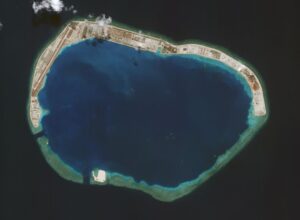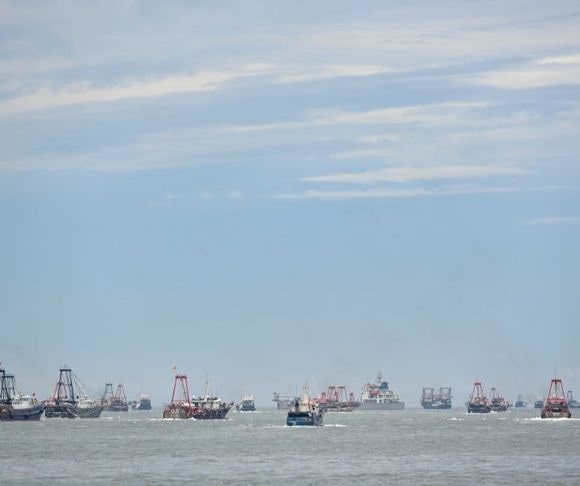One of the major themes discussed within US military circles is Anti-access/Area Denial (A2/AD) and how to overcome an enemy’s capability to deny US access to sea lines of communication. China has slowly but methodically created an A2/AD capability in the South China Sea. The topic was more urgent when contemplating how US naval vessels, particularly aircraft carrier battle groups (CVG), would engage the Cold War Soviet Union. One of the critical objectives of the Soviets was to protect the homeland from sea-borne attacks by NATO and US naval fleets. Looking back at the challenge Moscow’s sea power forces faced, there were very narrow gaps throughout the Barents and Norwegian seas, hampering naval operational maneuvering.
China Presents US with Anti-access/Area Denial Dilemma
The US Navy faces a similar but potentially more daunting problem in the South China Sea and the Straits of Taiwan. With the rapid illegal occupation of islands and infrastructure building, including fighter- and bomber-capable runways on what was at one time shallow coral reefs, China has created operating bases capable of restricting military and commercial maritime traffic. The new military installations allow the People’s Liberation Army Air Force (PLAA) and Navy (PLAN) air interdiction and intelligence collection coverage of the South China Sea and much of the Taiwan Straits. In a recent report from The Wall Street Journal, author Niharika Mandhana explained:
“The disputed sea is ringed by China, Taiwan and Southeast Asian nations, but Beijing claims nearly all of it. It has turned reefs into artificial islands, then into military bases, with missiles, radar systems and air strips that are a problem for the US Navy. It has built a large coast guard that among other things harasses offshore oil-and-gas operations of Southeast Asian nations, and a fishing militia that swarms the rich fishing waters, lingering for days.”
The amount of trade transiting the South China Sea is significant. In 2016, approximately “$3.4 trillion in trade passed through the South China Sea in 2016,” according to the Center for Strategic and International Studies China Power Project. More important, the US Energy Information Administration (EIA) calculated as far back as a decade: “About 6 trillion cubic feet of liquefied natural gas, or more than half of global LNG trade, passed through the South China Sea in 2011.” EIA estimated at the time that this amount would increase. Furthermore, with the reduced supply of LNG from Russia since the Kremlin’s invasion of Ukraine, the South China Sea has become an even more necessary channel for energy transportation.
China’s claim on territorial water far outside the internationally recognized territorial limits provides the PLAA and PLAN the excuse and the opportunity not only to harass and intimidate ships passing through the waterway but to limit or close maritime traffic in the South China Sea. “Keeping the channels open is critical to global commerce, and this body of water cannot be held hostage by China,” Liberty Nation reported over two years ago.
China’s Island Outposts Are a Menace
Though the People’s Republic of China (PRC) outposts have the disadvantage of being stationary facilities, the military installations remain a threat. “Three of the outposts in the Spratly group of islands are full-fledged military bases that host airfields, surface-to-air and anti-ship missiles, radars, and sensors that allow China to see and hear almost everything that happens in the area,” Mandhana reported. Additionally, the coverage of the PLAA combat fighter aircraft radius of coverage includes portions of Cambodia, Laos, Philippines, nearly all of Vietnam and Indonesia, and all of Malaysia and Brunei.

Chinese artificially increased the land area and built airfield on Spratly Islands’ Mischief Reef with support infrastructure despite disputed ownership. Satellite Image (c) 2022 Maxar Technologies.
Nonetheless, PRC has a vast amount of area to defend and, looked at from another perspective, the Chinese forces on the occupied islands are surrounded. Moreover, the PLAN has only two operational aircraft carriers, with another one not fully combat-ready. In any event, the carriers would have a long way to deploy to defend the new island bases. But, as the US has seen, China is persistent in building a military capability to be preeminent in their geographic neighborhood.
It’s often difficult to predict an adversary’s objective. However, the PRC persistently gobbling up coral atolls and small islands and establishing a permanent presence creates a strategic regional problem for the US and its Indo-Pacific allies and friends. So, the US might be wise to do what it does best – demonstrate with sea power and its presence US intentions to keep the South China Sea open for commerce and military transit.
The views expressed are those of the author and not of any other affiliation.




